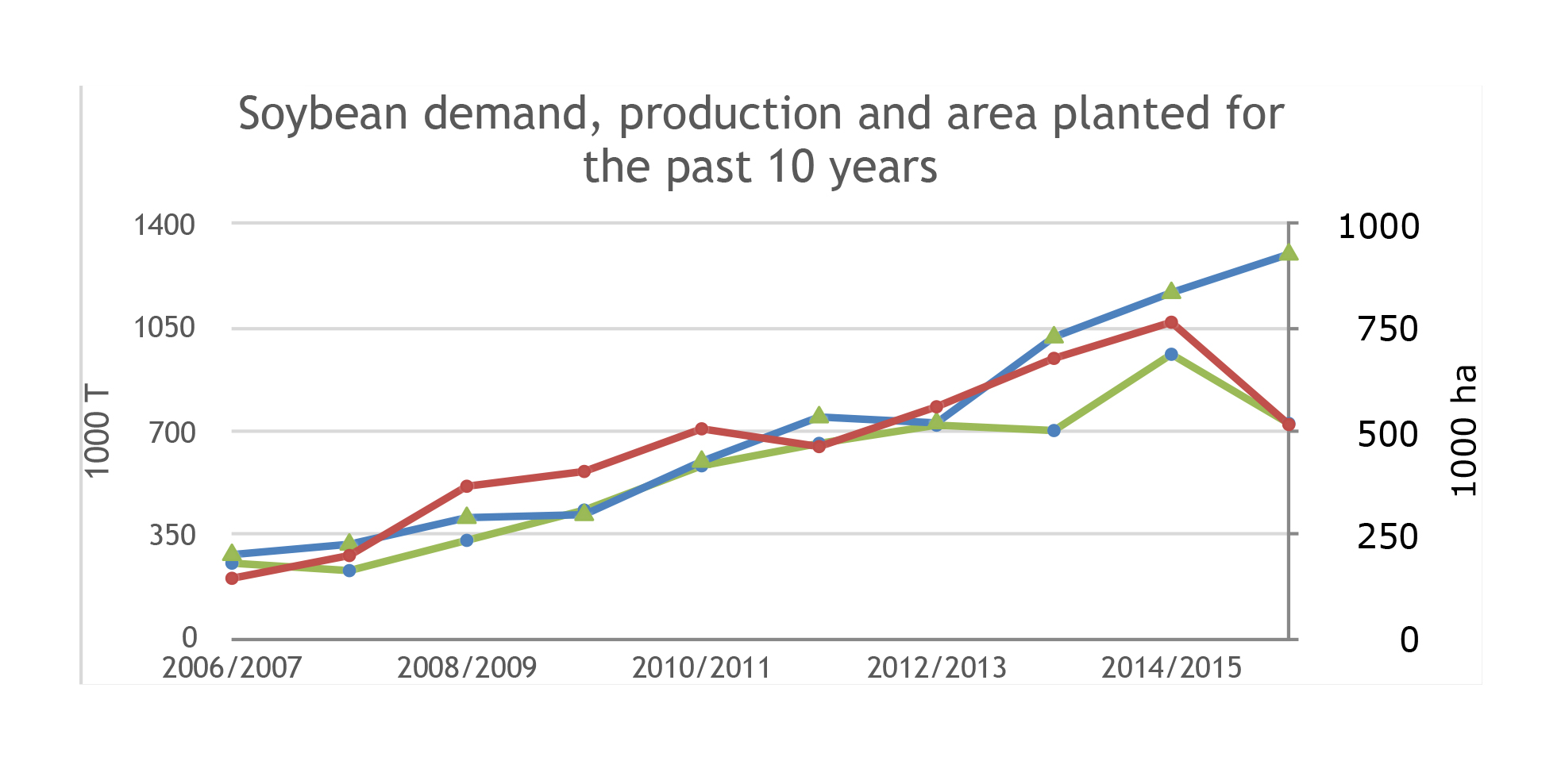Soybeans could be viable alternative crop in light of maize oversupply
Submitted by: MyPressportal Team
The demand for soybeans has outstripped supply since 2013, which could make it a viable alternative for farmers in the next production year. This is especially true for maize farmers, following this year’s massive over-production, the potential for carry-over stock into next year and the resultant drop in maize prices.
According to Paul Henning, business development manager at Laeveld Agrochem, the local demand for soybeans has almost doubled from the 2012/13 season to 2015/16 season – from 730 000 ton to 1.3 million tons. But despite the increase in demand, the production of soybeans has lagged, as can be seen
in the accompanying graph.
 400
400
Graph: Soybean demand, production and area planted in SA for the past 10 years (Source: Grain SA. 2016)
According to Grain SA, the higher demand stems from South Africa’s increase in oil press capacity, which has jumped from 860 000 tons in 2012 to 2.2 million tons. However, currently only about 1.3 million tons of the press capacity are being utilised.
The Crop Estimates Committee’s latest figures, released late last month, show an expected soybean crop of 1.34 million tons for this year, which is almost double than that harvested in 2016.
Soybeans have a diverse range of uses, including crude-oil, oil and as a source of protein. For human consumption, soybeans are used in oil and processed food stuffs. On an industrial level, soybeans are used as ingredients in soap, paint, bio-diesel and plastic.
Soybean cake is one of the most important protein ingredients in South Africa’s animal feed industry.
Table: The consumption of soybean cake and oil. (Source: Department of Agriculture,
Forestry and Fisheries. Food Analysis Report 2015)
| Demand | Consumption (%) | Consumption |
|---|---|---|
| Soybean cake | 32% | Ingredient for various industrial products, e.g. soap, bio-diesel, plastic, paint. |
| Animal feed | 60% | Due to the growing demand for broiler chicks and eggs, as population figures increase. |
| Human consumption | 8% | Sauce, oil and processed foods that serve as a great source of protein. |
| 100% |
Soybeans are one of the world’s most important seed legumes, contributing to 25% off all edible oils and about 66% of the world’s protein concentrate for livestock feeding. The United States is the world’s top soybeans producer, contributing to more than a third of global production.
Soil health for growing soybeans
According to Laeveld Agrochem, a holistic approach in growing soybeans must be applied, which takes into consideration the impact of the soil’s physical, chemical and biological factors. Effective soil management is crucial in ensuring successful growing conditions. The soil is the basis for the plant cultivar, the correct fertilization and biological factors involved in the growing of soybeans.
Using Rhizobium bacteria is helpful for producers, as it saves on the use of nitrogen fertilizer. Rhizobium fixes nitrogen from the atmosphere.
Also, it is common knowledge that this Rhizobium bacteria inoculation process must be successful, to partly ensure the fertilization requirements of the soybean.
Producers must be aware of the potential economic and financial losses that the fungus Sclerotinia sclerotium can cause. Laeveld Agrochem has the knowledge and has access to aids to control the sclerotia of Sclerotinia sclerotiorum and Sclerotinia minor when used in soil treatment (see included photo for an example of Sclerotinia).
Additional information
Soybean cultivation
Detailed manuals on the production of soybean, and information on pH, soil types, plant density and climate can be found at
- Pannar Seed (Pty) Ltd: Soybean Production Manual. See www.pannar.com
- Arkansas Soybean Production Handbook by Larry C. Purcell, Montserrat Salmeron and Lanny Ashlock.
- Laeveld Agrochem: 012 940 4398 or www.laeveld.co.za. The group has technical specialists that can assist with the effective cultivation of soybeans.
Latest from
- Profitroom secures key investor for global expansion
- Treat Yourself to a DIY Spa Experience with Nuts About Cooking Coconut Oil
- Shine Bright, Live Large: Discover the Unstoppable Energy of the HUAWEI nova 12 Series
- Latest Inflation Drop: A Welcome Breather For South African Consumers
- Revolutionising Fuel Payments: Aligning with Industry Trends

